Early Bird
Deadline
January 31, 2026
Judging
Date
May 18, 2026
Winners
Announced
June 10, 2026

Conegliano Valdobbiadene Prosecco Superiore DOCG is a story of authenticity, heritage, and a relentless pursuit of quality. Nestled in the undulating hills of northeastern Italy, this region crafts wines that have not only earned global acclaim but have also managed to retain a deep sense of place. As Diego Tomasi, Director of the Consortium Conegliano Valdobbiadene Prosecco DOCG, explains, the journey of Prosecco Superiore is as much about respecting its origins as it is about showcasing its modern-day appeal. From the time-consuming "heroic" viticulture on steep slopes to the introduction of innovative sustainability practices, Conegliano Valdobbiadene has upheld the essence of its terroir while expanding its reach to over 180 countries. The region’s distinct micro-zones, its ancient “Rive” vineyards, and its famed Cartizze wines embody the craftsmanship that defines this sparkling wine district. As we explore the celebrated wine region, it becomes evident that the soul of Prosecco Superiore lies in its ability to adapt while never losing sight of its roots.
Conegliano Valdobbiadene Prosecco Superiore DOCG is produced in a small area, of just 15 municipalities, situated in the northeastern part of Italy, in the Veneto region, between Venice and the Dolomites. The hills of Conegliano Valdobbiadene represent the birthplace of this wine, where its production started three centuries ago. The success of our wine began in the 1960s when its identity was established and the entrepreneurs of the hills of Conegliano Valdobbiadene began to travel and promote Prosecco in the world, like true 'Marco Polos.’ The first containers were sent to the United States in those years, and we also began to export to Germany.
This success was consolidated in the 1990s when Prosecco developed from a wine with which to toast Christmas or Easter to a wine to request and enjoy at any time of year. Enjoying Prosecco had established itself as part of a lifestyle. Its success was also sustained by a continuous improvement in quality, achieved through increased production controls as well as scientific collaborations with various Italian universities. Also during those years, a new generation started entering the companies; these young professionals had trained in marketing, languages, enology, viticulture, and more.
The story of the appellation continues to the present day. We are encouraged by its success in domestic and international markets, yet keep caring for the environment front and center. In 2023, we produced 7.7 million cases, 40% of which were exported to 180 countries in the world. Yet, despite this global reach, we always maintain authenticity, respect tradition, start from the same terroirs, and use the same grape variety as well as the same production method both in the vineyard and cellar (the latter being the Martinotti – or Charmat – method). The delicate, perfumed, and elegant wines of Conegliano Valdobbiadene Prosecco Superiore DOCG introduced a new style of drinking around the world.
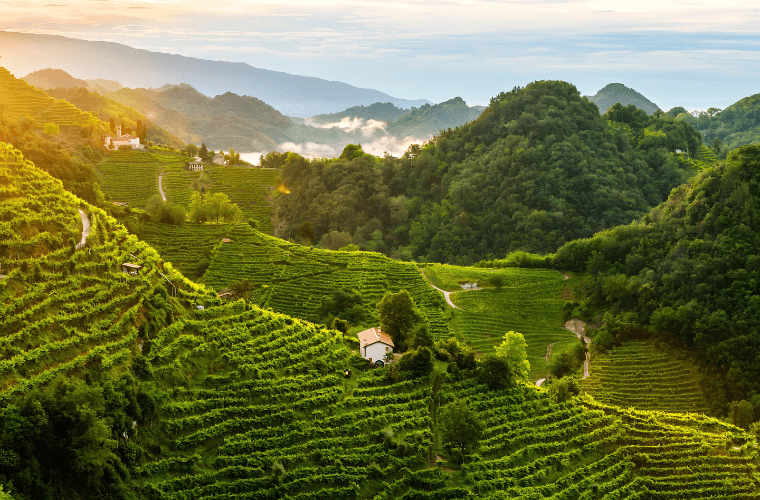
Image: Conegliano Valdobbiadene Prosecco Superiore DOCG.
Rive wines must come from a single commune or hamlet, so are a true expression of their terroir. The term “Rive” refers to the particularly steep vineyards in which the grapes for these wines are grown. Each finished wine reflects its microclimate, specific soil type, sun exposure, and climatic conditions of the year, offering a vivid snapshot of its unique origin. In addition to being hand-harvested as are all of our wines, the maximum yield is lower than for the rest of the region.
Rive wines reflect the highest standards of craftsmanship, and the best way to teach trade and consumers about these wines is to provide tasting experiences; side-by-side comparison allows consumers to appreciate the nuanced flavors and aromas of Rive wines firsthand, and helps translate the abstract concept of terroir into a tangible – and taste-able! – experience.
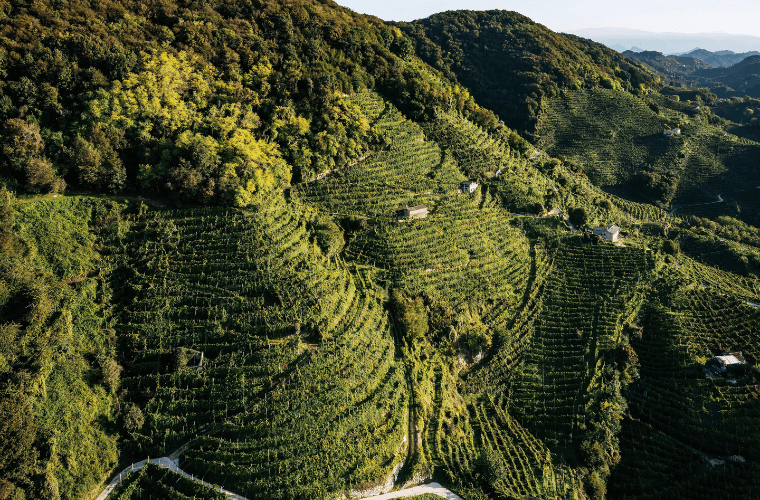
Image: Le Rive del Conegliano Valdobbiadene
In 2023, Conegliano Valdobbiadene was recognized by the Veneto Region as Italy’s First Sparkling Wine District, because we specialize in one specific product, Conegliano Valdobbiadene Prosecco Superiore DOCG, as well as have a deep tradition and know-how in sparkling winemaking, thanks to our passionate community of producers as well as the important training centers and research institutes located in the area.
Three distinctive elements particularly characterize our area and serve as the basis of our success.
First, our unique terroir, with its various soil types and micro-climates, is a key element in the quality of our wine. Our steep slopes and ciglione terraces (these are terraces held in place only by earth and roots) require “heroic” viticulture, meaning that all of the vineyard work has to be done by hand. It takes around 600-800 hours per hectare per year to manage the vineyards in our region, compared with 200 hours down on the plains. Yet, this time-consuming hand labor leads directly to the superior quality of the wines.
The second distinctive element that characterizes our area and contributes to our success is our culture of wine. Italy’s very first school of enology, the Scuola Enologica di Conegliano, was founded in 1876, and to this day it trains the young generations.
The third distinctive element is the human factor: our appellation is characterized by women and men who work with enormous passion. This community of producers hands down their know-how from generation to generation, creating great expertise.
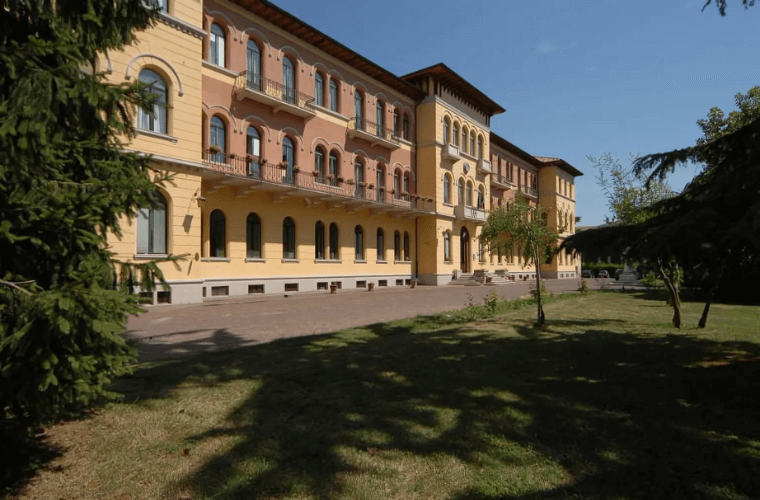
Image: The first School of Viticulture and Enology in Conegliano, Italy.
We have 5 key pillars related to sustainability. The first was the 2011 introduction of a Viticulture Protocol, which guides the use of integrated vine protection methods to manage crop protection products responsibly. Then, in 2019 the glyphosate ban went into force. That same year, Conegliano Valdobbiadene became the largest glyphosate-free zone in Europe, promoting soil health and biodiversity, and we still hold that distinction.
Also in the vineyards we pursue a Zero Nitrogen Project, dedicated to eliminating chemical nitrogen in order to reduce greenhouse gas emissions and support environmental health. We also have a project called Eno Bee, which works to increase bee populations, which are of course crucial for ecosystem health (as well as a way to monitor this). Since 2019, a freeze on new vineyard plantings has also been in place to protect existing environmental biodiversity.
Approximately 42% of our vineyards are certified by the Sistema Qualità Nazionale Produzione Integrata (SQNPI), an Italian certification that prescribes guidelines mostly related to soil fertility, pest management, and the use of chemicals. As a region, we plan to reach 100% certification by 2029.
Lastly, we focus on reducing CO2 emissions and noise pollution by using electric technologies and transport.
We hold ourselves accountable via Sustainability Reporting: we published our first Sustainability Report in 2024, aligning with global standards to cover environmental as well as economic and social sustainability aspects of the supply chain.
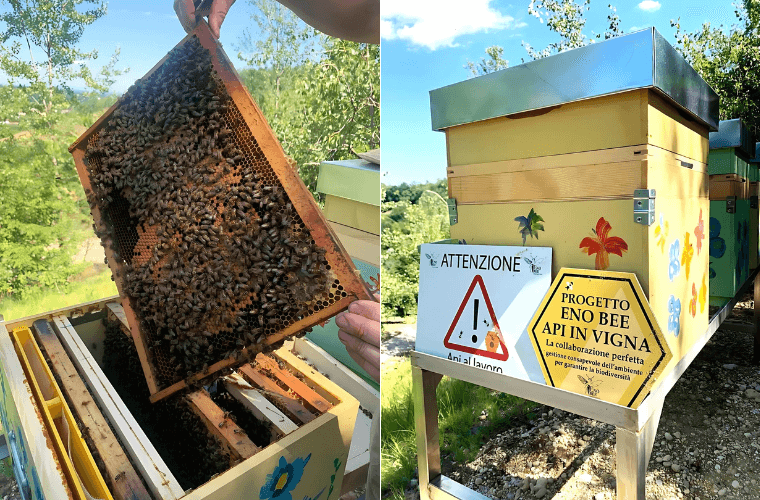
Image: “Eno-Bee” project - Sustainability initiative that enhances biodiversity and helps maintain the high quality of grapes. Source:Consorzio Conegliano Valdobbiadene Prosecco Superiore.
Cartizze is celebrated as the pinnacle of Prosecco Superiore. These wines are produced in a remarkably small area of just 106 hectares (267 acres), making Cartizze a rare and coveted gem in the world of fine wines. By underscoring its limited production, we highlight the exceptional nature and elite status of Cartizze.
Located on the steepest hillsides of Valdobbiadene, the vineyards benefit from a special combination of soil types – mainly calcarenite soil extremely rich in limestone – and an ideal microclimate for Glera grapes. The rich soil composition; mild climate; high diurnal swing; a constant flow of fresh air; and well-balanced water availability all contribute to the complex and refined flavors of Cartizze. The nose is characterized by complex aromas of ripe apples and pears, citrus, peaches, apricots, and floral hints (especially rose), along with a note of almonds in the finish. The flavors are well-balanced and elegant, with very fresh, mellow fruit underpinned by delicate, fine bubbles.
Sui Lieviti, also known as “col fondo,” is a traditional style that celebrates the origins of Prosecco Superiore. It is produced using an artisanal method in which the yeasts that facilitate the secondary fermentation remain in the bottle, creating a slightly cloudy appearance. This method imparts a distinctive character to the wine, with complex aromas of crusty bread and a fuller, richer flavor profile.
Unlike the clear Prosecco Superiore styles, which are known for their crisp, apple-like notes, Sui Lieviti wines offer a rich, textured experience. They pair well with traditional Venetian dishes and provide a unique tasting experience due to the natural variations in each bottle caused by the evolving yeasts.
Educating consumers involves emphasizing the historical significance and artisanal nature of this style, showcasing its unique taste profile, and demonstrating how it complements traditional cuisine. By sharing these insights, consumers can better appreciate the Sui Lieviti style as a valued part of Prosecco Superiore’s diverse heritage.
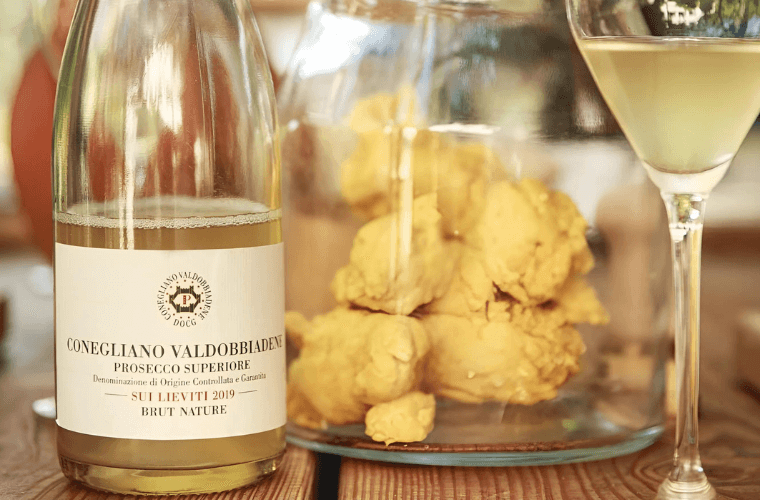
Image: Sui Lieviti; source: Prosecco Consortium
In the past, Venetian nobles built their summer homes in the Conegliano Valdobbiadene hills: our moderate annual temperature averages 12.3°C (54.1°F), we have a consistent breeze due to our altitude of 50-500 meters (165-1,640 feet), and our orientation draws cool air from the Adriatic Sea and Piave River. We have hot, dry summers and mild winters due to the Alpine foothills – most specifically the Venetian Prealps – that block the cold air coming from the north, therefore protecting our hills.
Our vineyards enjoy these conditions as much as the nobles did! The vineyards also benefit from Conegliano Valdobbiadene’s “hogback” hills, which are very peaked, steep hills: imagine the way a wild boar’s back descends from its spine. Between these run parallel hills and valleys formed by millions of years by tectonic and glacial activity. The frequent summer showers and well-drained slopes, along with the high diurnal swing I mentioned before, contribute to the development of grapes with rich aromas and balanced acidity.
In short, we have a visually stunning and complex terrain that provides diverse microclimates for vine growing; a rare combination of geographical and climatic conditions which shape the character of our wines; and a history which creates a sense of timeless quality and prestige. All of these combine to resonate with wine enthusiasts globally.
[[relatedPurchasesItems-61]]
While adapting our messaging to resonate with local tastes and traditions, in every market we emphasize the versatility of Conegliano Valdobbiadene Prosecco Superiore by showcasing its ability to complement a wide range of cuisines. Whether it’s the traditional flavors of Treviso or contemporary international dishes, Prosecco Superiore adapts seamlessly, appealing to diverse palates around the world. And, above all, we have consistent messages about the essence of Prosecco Superiore and the Conegliano Valdobbiadene region based on heritage, quality, and unique characteristics.
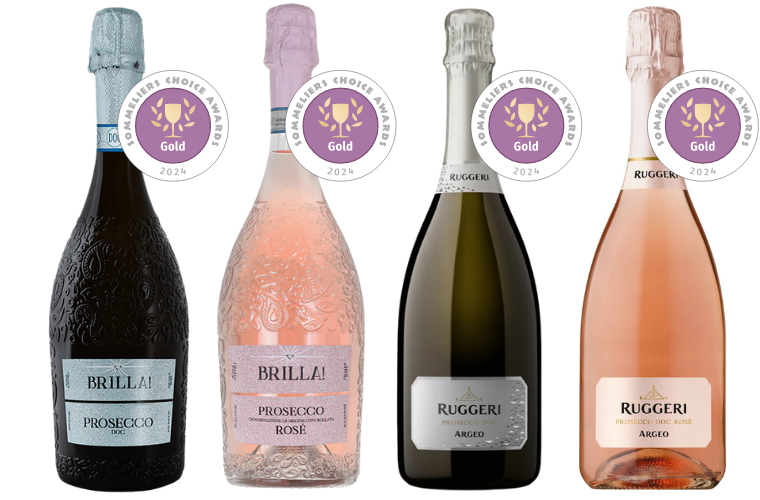
Image: Winners of 2024 Sommeliers Choice Awards - Brilla Prosecco, Brilla Prosecco Rose, Ruggeri Prosecco DOC Argeo, Ruggeri Prosecco DOC Rose Argeo
Our most pressing challenge is to ensure consumers recognize the differences between the different quality levels of Prosecco: we need to ensure that Conegliano Valdobbiadene Prosecco Superiore continues to be understood as a premium product amidst increasing global competition. A very important part of our role is to effectively communicate the distinctive elements of Conegliano Valdobbiadene Prosecco Superiore to trade and consumers alike. Differentiation remains a critical task and reinforcing our unique selling points will be crucial in maintaining our premium positioning.
While we are very proud of the environmental strides we’ve made – including the elimination of glyphosate and the implementation of the Viticulture Protocol, Zero Nitrogen, Eno Bee, SQNPI, and sustainable mobility programs – there is still more to do. We must continue to innovate and invest in sustainable practices that align with our environmental goals yet balance environmental stewardship with productivity. Also, achieving comprehensive environmental certification for the entire region and increasing organic cultivation will be critical to our community, our wines, our business, and even to attracting tourism.
Another challenge, though it is also an opportunity, is the “heroic” viticulture that our region demands. This requires considerable investments in workforce, time, and resources, leading to higher costs. Maintaining this tradition while managing these costs and investments will be crucial for preserving the quality and heritage of our Prosecco.
On a technical yet still understandable level, a focus on our terroir-specific Rive wines presents a significant opportunity to differentiate our Prosecco in the premium segment. Ongoing research and publishing zoning studies can help position Conegliano Valdobbiadene as a leader in the premium sparkling wine market.
Lastly, another opportunity is our prestigious UNESCO World Heritage status, which was granted in 2019. We are one of only ten Italian winemaking regions with this status and gained ours for our hogback hills and ciglione, as well as our patchwork landscape made by our approximately three thousand small-scale wine growers at work. This has already helped us elevate our global profile, enhance wine tourism, attract more international visitors, and promote our region as a premier destination for wine enthusiasts and cultural tourists alike.
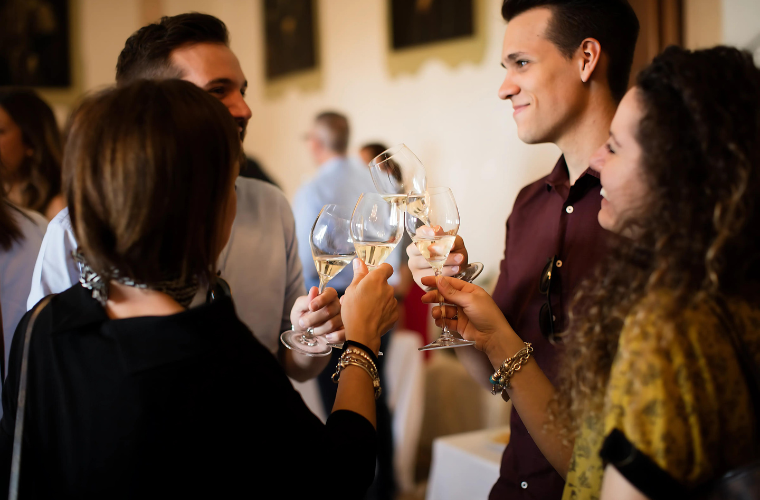
Image: A Brindisi for Conegliano Valdobbiadene Prosecco Superiore DOCG.
Tasting events that focus on the unique qualities of Conegliano Valdobbiadene Prosecco Superiore allow us to present our wines in a controlled, informative setting. By including guided tastings that highlight the nuances of our Prosecco Superiore’s terroir, production methods, and distinct characteristics, we engage attendees in a deeper appreciation of the wine. These events often include food pairings that complement the Conegliano Valdobbiadene Prosecco Superiore, showcasing its versatility. Educating and collaborating with local experts also amplifies our message, provides credibility, and reaches diverse and broad audiences.
The success of Conegliano Valdobbiadene Prosecco Superiore DOCG lies in its unwavering commitment to quality, authenticity, and respect for its terroir. As Diego Tomasi emphasizes, the future holds both challenges and immense potential – from distinguishing Prosecco Superiore as a premium product to advancing sustainability efforts and embracing the unique, "heroic" viticulture that defines the region. By upholding its unique microclimates, hand-crafted traditions, and unparalleled dedication to excellence, Conegliano Valdobbiadene continues to shine on the global stage, embodying the spirit of Italy’s most prestigious sparkling wine.
So next time you raise a toast with Prosecco Superiore, remember—you’re not just enjoying a drink; you’re experiencing a rich story that’s been centuries in the making.
In conversation with Malvika Patel, Editor and VP, Beverage Trade Network
Also Read:
A Taste of Italy: Lamberto Frescobaldi's Leadership at the UIV
The Top Italian Wine Importers in the USA: Bringing Italy's Finest to American Shores
Introducing the Second Batch of Ambassadors for the 2025 Sommeliers Choice Awards
Enter your Wines now and get in front of top Sommeliers, Wine Directors, and On-Premise Wine Buyers of USA.
